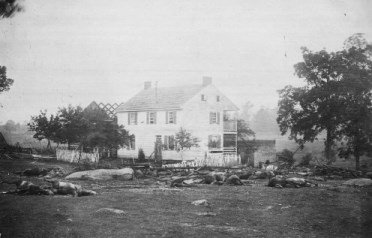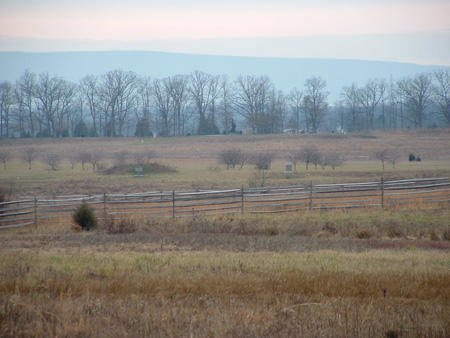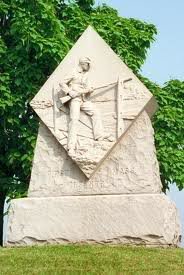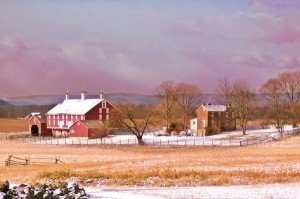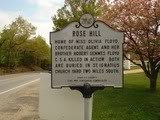The Battle for the Wheatfield at the Rose Farm
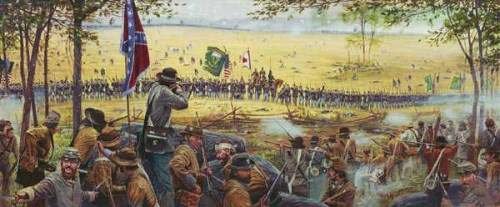
The Pride of Erin by Dale Gallon
The Farm was at the center of some of the fiercest fighting on the second day of the battle, July 2, 1863. Its features include Stony Hill, Rose Woods, and a twenty acre field that has come to be known simply as the Wheatfield. There, over 20,000 men engaged in brutal and often hand-to-hand combat leaving over six thousand killed or wounded.
Fighting at the Rose Barn
During the battle of July 2, the Rose barn was first used to shelter Union skirmishers and sharpshooters who were protecting their army’s left flank. When the Confederate division of General Lafayette McLaws pressed these skirmishers back, the infantrymen of General Paul Semmes took shelter in the barn to avoid deadly artillery fire. Many Southerners remembered long afterward the sound of the shell and canister as it clattered against the stone.
After the fighting of July 2 ended, the barn was impressed into service as a field hospital by the Confederates. Those who died there were buried around the outer walls of the building. A windstorm unroofed the barn during the 1930s and it decayed rapidly. All that remains today are the stone walls of the barn’s foundation.
Attack and Counterattack at the Wheatfield
The wheatfield that belonged to the Rose family is about twenty acres in size and somewhat trapezoidal in shape. Situated between Devil’s Den and The Peach Orchard, it was to become forever known simply as the Wheatfield. It is aproximately 300 by 400 yards and surrounded by wood lots.
On the northern edge is Trostle’s Woods and a road known simply as the Wheatfield Road. A worm-rail fence on the western edge separates the field from the woods and a rock strewn knoll known as the Stony Hill. A stone wall separates the Wheatfield from Rose Woods on the southern edge. To the east of the Wheatfield is Little Round Top, the objective of the Confederate tidal wave that came through this area.
At 4:00pm on the afternoon of July 2, 1863, fighting exploded at Devil’s Den, and for the next three hours, a seesaw battle raged at the Peach Orchard, Trostle farm, Devil’s Den and Rose farm. The Wheatfield alone changed hands six times. Making the first Confederate assault on the Wheatfield was the brigade of General George Anderson of General John Bell Hood‘s division. These regiments had already met hot fire crossing the farm.
USA General David Birney called on Colonel Philippe Regis De Trobriand and his brigade of five regiments from Michigan, Pennsylvania, New York and Maine for help. De Trobriand’s 17th Maine was sent to the stone wall that divided the Wheatfield and Rose Woods. Shortly thereafter, the Confederate assault advanced with a Rebel yell, preceded by a rush of terrified cattle and hogs.
Anderson swept through the woods to the south and collided with De Trobriand’s force, and the fighting was fierce. The 11th Georgia streamed forward and placed its colors on the stone wall held by the 17th Maine, but they were repulsed. During the fighting that followed, a gap formed in the Union line, and the 8th Georgia pushed their way into it, forcing the 17th Maine into a new position along the rail fence on the edge of the Wheatfield.
As the 8th Georgia entered the gap the men received fire from both sides. The Georgians and the 17th Maine engaged in fierce hand to hand combat at the stone wall in the southwestern area of the Wheatfield, just at the edge of the Rose Woods. The Confederates slowly pulled back into the woods, but General Anderson was shot through the thigh as they retreated.
The fighting had been going on for almost an hour. At this point an uneasy calm came over the field, but it did not last long. As the fighting raged in the southern end of the Wheatfield, a brigade of South Carolina soldiers under General Joseph Kershaw were moving toward the Rose Farm from the west. General Kershaw later wrote:
In my center front was a stone house, and to the left of it a stone barn, both about 500 yards from our line, and on a line with the crest of the orchard hill. Along the front of the orchard, and on the face looking toward the stone house, the enemy’s infantry was posted. Two batteries of artillery were in position, the one in rear of the orchard, near the crest of the hill, and the other some 200 yards farther back, in the direction of the rocky mountain.
Behind the stone house, on the left, was a morass; on the right a stone wall running parallel with our line of battle. Beyond the morass some 200 yards was a stony hill, covered with heavy timber and thick undergrowth, extending some distance toward the enemy’s main line, and inclining to our left, and in rear of the orchard and the batteries described. Beyond the stone wall, and in a line with the stony hill, was a heavy forest, extending far to our right.
From the morass a small stream ran through this wood along the base of the mountain toward the right. Between the stony hill and this forest was an interval of about 100 yards, which was only sparsely covered with scrubby undergrowth, through which a small road ran in the direction of the mountain. Looking down this road from the stone house, a large wheatfield was seen. In rear of the wheatfield, and between that and the mountain, was the enemy’s main line of battle, posted behind a stone wall.
Assault on Stony Hill
The next wave of fighting at the Wheatfield began about 5:20pm. Weathering a hailstorm of shot, shell and canister as they crossed the open fields of the farm, General Kershaw’s troops moved in and assaulted Union troops on Stony Hill, the small rocky knoll that borders the west side of the Wheatfield. The fighting swelled to a crescendo and raged steadily for an hour, but Kershaw’s Rebels forced the Federals from the key positions they had occupied earlier.
The famed Union Irish Brigade arrived and tramped through the wheatfield to push the Confederates off the knoll. However, Kershaw renewed his attack with reinforcements from a Georgia brigade under General Paul Semmes, who led two of his regiments into a gap on Kershaw’s right in the lower part of the wheatfield. However, a fresh Union brigade soon counterattacked.
At the point of the bayonet, the Unionists drove Semmes’ men back to the farm orchards south of the house and the two sides fought it out in a seesaw struggle. Southern pressure was relentless and the Union forces began to withdraw from the Wheatfield and surrounding woods. The fighting was close and hand to hand. General Semmes was mortally wounded during this engagement.
Earlier in the day, General Daniel Sickles, without orders or permission, had moved his troops forward half a mile, creating a salient in the Union battle line. Now Sickles was leading his troops into the fray from the Trostle house, but he soon began to withdraw due to the pressure of the advancing Confederates. A cannonball struck Sickles in his right leg, which was later amputated by Union surgeons.
At 6:00pm the Confederate brigades of Generals William Barksdale and William Wofford advanced upon the Peach Orchard. After overwhelming the Union defenders there, Barksdale advanced in a northeastly direction as far as the Trostle farm. Wofford advanced due east down the Wheatfield Road and drove Union troops off Stony Hill and out of the Wheatfield.
The troops in Sickle’s III Corps who had been initially positioned there were now all withdrawn from the Wheatfield. Help was sought and came from the the 1st division of the Union Army’s II Corps, which was commanded by General John C. Caldwell and consisted of four brigades, one of which was commanded by General Samuel Kosciuszko Zook. As he rode ahead of his men, Zook was mortally wounded by a Confederate bullet in the abdomen, and died later that night.
Caldwell’s division approached via the Wheatfield Road on the north side of the Wheatfield as the Confederates drove the Union troops from its southern and western sides. Caldwell’s brigades charged the Confederates among the wheat and the surrounding woods, driving them back. However, the Confederates reformed quickly and counterattacked.
Coming to their aid were General Wofford’s Georgia brigade, who had helped break the Union line at the Peach Orchard and were now hurrying down the Wheatfield Road on Kershaw’s left. As Caldwell attacked, two Union brigades of Regular Army infantry of General Romeyn Beck Ayres approached the Wheatfield from the east. When Caldwell’s men fell back, Ayres’ men delayed the Confederate assault until the retreating troops could set up a defensive position.
This final Confederate assault through the Wheatfield continued past Houck’s Ridge into the Valley of Death at about 7:30pm. The brigades of Anderson, Semmes and Kershaw were exhausted from hours of combat in the summer heat and advanced east. Wofford’s brigade followed to the left along the Wheatfield Road. As they reached Little Round Top, they were met with a counterattack from the 3rd Division of the V Corps under General Samuel Crawford. Realizing that his troops were too far advanced, Crawford pulled back to the eastern edge of the Wheatfield.
At this point, only General Ayres’ troops remained to meet the Confederate units that had captured the Wheatfield. Ayres’ Regular brigades spent less than an hour in the Wheatfield and accomplished little. They had protected Caldwell’s retreat, but suffered 800 casualties in the process. With Ayres’ withdrawal, there were no blue units west of Plum Run or south of Trostle Lane. General James Longstreet‘s Corps had successfully smashed through Sickle’s precarious line.
The Fighting Ends
By 8:00pm, as darkness settled over the bloodstained wheat, all that remained were the groans of the wounded and dying between Little Round Top and the Peach Orchard. Some of the wounded crawled to Plum Run, but could not cross it. The Peach Orchard, the Trostle farm, Devil’s Den and the Wheatfield were now in Confederate hands, but the Army of the Potomac still held their strategic positions on Little Round Top. The Rebels had reached Plum Run at the base of Little Round Top but could go no farther.
The loss of life in the Wheatfield was horrific. Charge and counter charge had left the field and surrounding woods strewn with the bodies of more than 6,000 dead and wounded Union and Confederate soldiers. The 61st New York lost 60% of its number, killed or wounded. The 53rd Pennsylvania lost 59% of its men. The 17th Maine lost 58%. Overall, Union regiments averaged losses of approximately 33%. The Confederates suffered similar losses.
Though not as famous as other areas of the battlefield, the gallantry and hard fighting at the Rose Woods, Stony Hill and the Wheatfield was among the best in the Battle of Gettysburg. Four of the seven Union corps were involved in those three and a half hours of sustained fighting. Counting both Northern and Southern forces, sixteen brigades, 68 regiments and over 21,000 men fought in the Wheatfield area.
Alexander Gardner took some of Gettysburg’s most famous photographs at the Rose Farm after the fighting ended there. The farm’s outbuildings were used as a Confederate field hospital, and it is estimated that between 500 and 1,000 Confederate soldiers were buried on the property. The stone farmhouse is still standing, but all that remains of the barn is its stone foundation.
SOURCES
The Gettysburg Wheatfield
Thomas Legion: The Wheatfield at the Battle of Gettysburg
